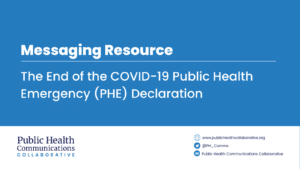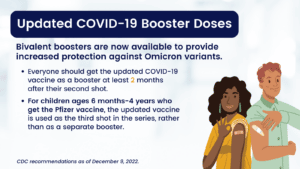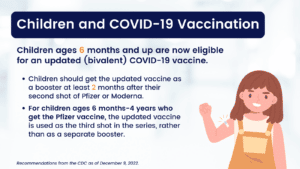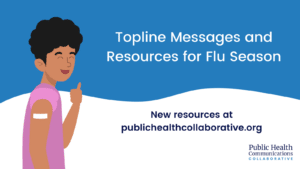According to the most recent 2024 data from the Centers for Disease Control and Prevention (CDC), the United States has reported a total of 35 measles cases across 15 states: Arizona, California, Florida, Georgia, Indiana, Louisiana, Maryland, Minnesota, Missouri, New Jersey, New York City, Ohio, Pennsylvania, Virginia, and Washington.
Use the following messaging to keep your community members informed about the spread of this highly contagious and potentially fatal disease and the actions they can take to protect themselves. Although this outbreak has many impacts on public health and safety, this messaging guide is designed to communicate the information that is most relevant to the general public. We recommend adapting messaging for your local context.
Topline Messages
- Measles is a highly contagious disease with serious possible complications including hospitalization, long-term illness, and death. Someone who is infected can spread the disease to other people before noticing any symptoms, especially in the four days before and after the rash develops.
- CDC data show that unvaccinated people have a very high likelihood, about 90% risk, that they will contract measles if exposed. Unvaccinated children who have not previously been infected are more likely to get infected and should avoid exposure.
- One in five children who contract measles will be hospitalized.
- One in 20 children who contract measles will develop pneumonia.
- One to three children who contract measles in 1,000 will die.
- CDC data show the measles-mumps-rubella (MMR) vaccine is highly effective. Individuals with a history of prior infection or vaccination who have received the full series of MMR vaccines are 97% protected and are unlikely to contract measles.
- It only takes a few days for antibodies to develop in response to the MMR vaccine. Within two to three weeks, the immune system is fully primed after vaccination.
- Measles infection can cause “immune amnesia” or immune suppression, effectively erasing the immune system’s memory and protection from other diseases. This immune weakening can last anywhere from weeks to years. This increases the risk of infection due to secondary bacterial and other infections, even if you have built immunity from a previous infection.
Supporting Messages
The following information can be used in communications responses related to measles transmission, exposure, vaccine guidance, and vaccine safety information. This is not an exhaustive list to address the outbreak situation, and health departments and other organizations should consult federal and state authorities in developing responsive communications for their priority audiences.
Background on Measles
Measles is one of the most highly contagious air-borne diseases and is amongst the global leading causes of death in children, despite the existence of a highly effective and safe vaccine. Medical and public health experts, including the CDC and the American Academy of Pediatrics, recommend that children and adolescents aged 6 months and older get an MMR vaccine to help protect them from serious illness. Children under five years of age, adults over 20 years of age, pregnant people, and people with immunocompromised health are most at risk of measles complications.
Measles infection causes a rash to appear, alongside high fevers, diarrhea, coughing, runny nose, eye and ear infections. Someone who is infected can spread the disease to other people before noticing any symptoms, especially in the four days before and after the rash develops. In severe cases, measles causes children’s brains to swell, leading to seizures, deafness, cognitive disability, and possibly death. About 1 in every 20 children with measles also contracts pneumonia, the top cause of pediatric death from measles, a serious respiratory illness. Measles even causes immune system weakening that can last weeks to years. A suppressed immune system increases the risk of infection due to secondary bacterial and other infections.
Measles outbreaks are on the rise again in the United States after reaching national eradication in 2000. Measles outbreaks are most common in communities where larger groups of people are unvaccinated. This is a major public health concern given that about 1 in 5 unvaccinated people in the U.S. with measles require hospitalization.
Since 1968, the United States measles vaccine has been the single most effective and safe approach to ensure people do not experience hospitalization, long-lasting health impacts, or death due to this viral disease.
Exposure Guidance
The most helpful actions someone can take to prevent the spread of measles include isolating if they have a rash or believe they have been exposed, wearing a mask if around others, and contacting a healthcare provider immediately. Isolation is a key health precaution used to prevent people with confirmed or suspected measles from spreading the virus through respiratory droplets or cross-contaminated surfaces.
-
If you become sick and have not been vaccinated against measles:
- Contact a healthcare provider immediately and alert them that you believe you were exposed to measles.
- Ask them about receiving an MMR vaccine and discuss treatment options.
- You should isolate for 21 days after your exposure.
- You should wear a mask and disinfect surfaces when near others to avoid the spread of germs in the air and on common household items.
- Contact a healthcare provider immediately and alert them that you believe you were exposed to measles.
-
If you become sick and have been vaccinated against measles:
- Contact a healthcare provider immediately and alert them that you believe you were exposed to measles.
- Discuss your vaccine history with them as part of determining possible treatment options.
- You should quarantine to limit contact with others. You may be advised to stay home for four days if you develop the measles rash.
- You should wear a mask and disinfect surfaces when near others to avoid the spread of germs in the air and on common household items.
- Contact a healthcare provider immediately and alert them that you believe you were exposed to measles.
Vaccine Guidance
The CDC recommends that people of all ages protect themselves and their loved ones from measles, as well as vaccine-preventable diseases like mumps, rubella, and/or varicella (chickenpox), by getting the measles-mumps-rubella (MMR) or measles-mumps-rubella-varicella (MMRV) vaccines. These are both two-dose vaccines traditionally given during early childhood when the immune system is weakest against disease. It only takes a few days for antibodies to develop in response to the MMR vaccine. Within two to three weeks, the immune system is fully primed after vaccination.
- Two MMR vaccines are available for use in the United States: M-M-R II and PRIORIX vaccines.
- Children over 6 months are eligible to get two doses of the MMR vaccine, which protects against all known strains of measles. Children who are unvaccinated, under-vaccinated, or unsure of their vaccination status should receive an MMR vaccine immediately. Unvaccinated people who have been exposed to measles can still receive the MMR vaccine up to 72 hours after exposure to help prevent or reduce the severity of an infection.
- Typically, the first dose should be provided when the child is 12 to 15 months of age and the second dose when 4 to 6 years of age.
- The MMR vaccine doses are typically provided years apart due to their long-lasting nature, however, children in high-risk settings can get their second dose sooner, so long as it is 28 days after the first dose.
- Children who are traveling with family to overseas areas where measles is less controlled may require slightly different vaccine timing to provide the best protection while abroad. In most cases, children should complete the doses at least two weeks before traveling.
- Teens and adults should ensure they have completed the two-dose protocol to be best protected in the case of an outbreak.
- Pregnant people, people trying to get pregnant, or people who believe they could be pregnant should contact their healthcare provider immediately to test for measles and discuss vaccine options.
- Pregnant people may be advised to wait to get the MMR vaccine until they are no longer pregnant.
For additional and more personalized information about vaccine options, encourage your audiences to contact their healthcare providers.
Vaccine Safety and Effectiveness
Since the early 1950s, researchers and medical experts have worked to ensure that the measles vaccines are safe for people age 6 months and older. Today, MMR vaccines are routine for every child and most who receive the vaccine do not have any serious complications afterward. Decades of clinical trial data and monitoring tens of millions of vaccinated people have continued to prove the vaccine is safe and effective.
As early as the 1960s, research has shown that measles vaccines are highly effective in preventing disease and the complications caused by the disease after exposure. According to CDC data, receiving two doses of the MMR vaccine provides the highest level of protection, at 97% effectiveness. Even if only one dose is received, protection is still extremely high, at 93% effectiveness.
Communications Considerations
Here are some questions to consider when communicating about the measles outbreak and measles (MMR) vaccines.
Who is your audience?
The more specific you can get about your audience, the more effective you can be in providing useful, relevant information.
Consider:
- Do I know what type of insurance my audience has? Am I specifically targeting people with public, private, or no insurance?
- Am I communicating with individuals or organizations? If an organization, what kind of organization—school, employer, business, health care facility, etc.?
What do you want your audience to do with this information?
Examples:
- I want my community to follow specific guidance.
- I want constituents to reach out to their insurer if they have questions about specific vaccine coverage.
- I want community members to share this message with friends or family.
- I want trusted messengers to help amplify this information.
What is your local context?
Consider:
- Local or state policies regarding active outbreaks that will directly impact your community.
- Your county’s measles case rate.
Read our Plain Language for Public Health Guide for more tips for effective, relevant, and accessible communications.




